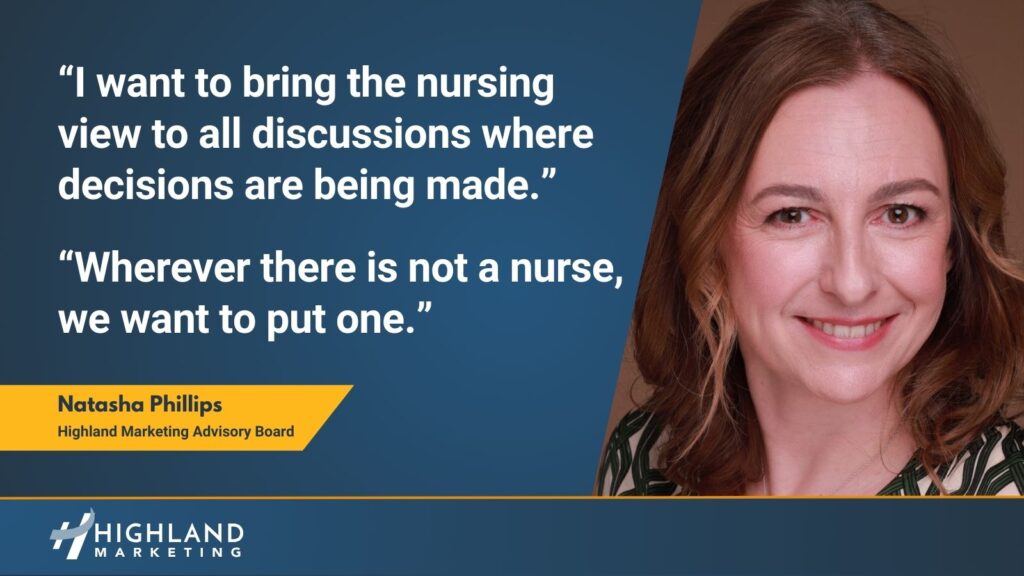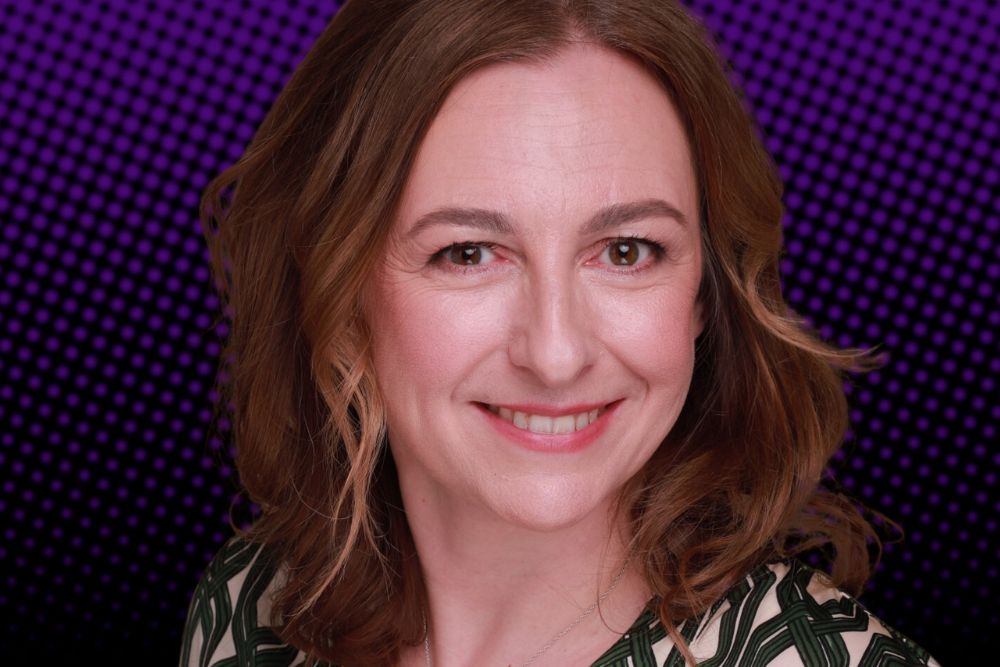The former NHS CNIO for England has joined the Highland Marketing advisory board. Here, she talks about her passion for transformation, the role of technology, and her mission to put nurses at the heart of debate about both.
Natasha Phillips is on a mission. “I want to bring the nursing view to all discussions where decisions are being made,” she says. “Wherever there is not a nurse, we want to put one.”
The red thread of a career
This is not a new mission for the nursing, transformation, and digital leader. Phillips started her career in London thirty years ago and has held many operational leadership roles.
She led large-scale change projects such as the Hospital@Night programme for Barnet and Chase Farm Hospitals NHS Trust, before moving to University College London Hospitals NHS Foundation Trust.
There, she led an exemplar ward transformation programme, before becoming chief nursing informatics officer, and heading up the first, enterprise-wide deployment of the Epic electronic patient record. That took her to NHS England, where she became the first CNIO in 2020.
“If you look at the red thread of my career, it is a passion for improving our health and care systems which has led me to take on roles and projects where I can do this.
“Early on, I recognised the value of working with colleagues in IT and analytics, to use data and technology to support effective clinical improvements.”
Creating a support network for digital nurses
One of the painful lessons the health service learned from the National Programme for IT in the NHS is that clinical engagement is essential if EPR deployments are going to be successful.
Doctors got involved as the chief clinical information officer role was established. But nursing involvement is more recent, and Phillips says she felt “lonely” leading UCLH’s EPR implementation.
To counter this, she linked in with colleagues in the US and Nordic countries “so there were other nurses who had been on the journey to learn from.” Her ambition as national CNIO was to make sure that other nursing colleagues felt similarly supported.
To this end, she led the production of a ‘What Good Looks Like’ framework for nursing aimed at board-level nurse leaders. The framework has seven success measures for the development of organisations in which nurses and other clinicians can work in a supportive digital healthcare environment, enabling them to provide safe and effective care.
She also co-chaired the Health Education England-commissioned ‘Phillips Ives Nursing and Midwifery Review.’ This built on the Topol Review to identify how person-centred practice will evolve as nurses use more technology to deliver care in the next five, ten and 20 years.
The findings highlight how education must shift to prepare nurses to deliver person-centred care in a digital health and care system.
Education and skills for life and leadership
Frustratingly, the review has yet to be published; but Phillips says it’s clear that digital education and skills will need to be shot through future careers.
“We need to start with undergraduate education, so people have the core skills they will need to make use of new technology when it is available,” she says.
“Then, we need to look at postgraduate education. If people are specialising – if they are becoming an asthma nurse, or whatever – then we need to ask: ‘where is the technology in that?’ Then, there are deployments, for which we need to talk about training, and how to make sure we are training people in context.
“And alongside all that, we have our CNIOs and nurse leaders in the digital space. We wouldn’t appoint somebody to a specialist job unless they had an appropriate qualification, and the same needs to apply to people choosing to work in digital. We have the NHS Digital Academy, but we need to do more.”
Frontline digitisation and investing in EPRs
The best education and skills are useless without good technology. NHS England is leading a £900 million frontline digitisation programme to complete the NPfIT agenda of digitising the acute sector by March 2026.
In an apparent bid to prevent some of the business continuity and reporting problems that have plagued some previous implementations, it is looking for “tiger teams” to go in and support trusts that have not deployed an EPR before.
However, Phillips argues the lesson of successful implementations, such as the one at UCLH, is to focus on benefits. “Trusts tend to decide to implement an EPR, and ask how they are going to do it,” she says. “Instead, they should ask what the benefits are going to be, and how to achieve them.
“That way, you can start the design phase earlier.” Plus, she adds, trusts need to invest in their EPRs on an ongoing basis. For example, she says, they need to focus on workforce engagement and change management to make sure the systems are fit for purpose and are reducing the administrative burden, not adding to it.
And they need to build-out newer ideas, like truly closed-loop electronic prescribing and medicines administration, with single unit dosing capabilities, and greater device integration, to further reduce that burden.

Finding the technology to solve problems
Digital transformation is about more than hospitals and about more than EPRs (even if they remain the focus of national leadership and press attention). Phillips certainly has plenty of items on her health tech wish-list.
“While we need technologies like EPRs to support more effective communication between care teams, we also need technology to support other areas of practice,” she says. “We are starting to see this with technology-enabled models for virtual wards and remote monitoring.
“Beyond this, we need the nursing workforce to generate the next wave of digital innovation that tackles challenges like the nursing workforce shortage.”
Examples exist. Phillips outlines one from University Hospitals of Leicester NHS Trust, which had a shortage of tissue viability specialist nurses. Using technology, specialist TVN nurses were able to attend the patient’s bedside to visualise the wound and guide a bedside nurse to manage it.
However, she says: “We need much more nurse led innovation like this to address the real challenges we face.”
A passion for change
Phillips became national CNIO as NHSX was formed. The unit aimed to bridge a gap between the Department of Health and Social Care and NHS England, to create space to develop NHS IT policy, and to make best use of the delivery capacity of NHS Digital.
In this environment, Phillips made great strides in advancing nursing’s inclusion in the digital agenda. During her tenure, the number of CNIOs in provider organisations grew to 85%, and this translated to a stronger clinical voice in digital change programmes up and down the country.
More recently, she moved on to establish Future Nurse, a consultancy working with the industry and the health and care system to support effective clinically-informed digital transformation.
Phillips describes this as a natural next step in her career, and one that is still defined by that red thread of passion for: “Making the NHS better, improving the lives of clinicians, and making sure that patients get great care.”
Nurses are now more involved in designing and implementing existing digital systems like EPRs. But next, nurses must be involved in identifying and ideating technological innovations.
“In this next stage of my career, I aim to create a much closer working relationship between nursing and health tech vendors,” she says.
“That will ensure technological innovations are informed by the challenges nurses face in daily practice and the opportunities they see to do things differently. Watch this space to see how we will deliver this through Future Nurse.”


